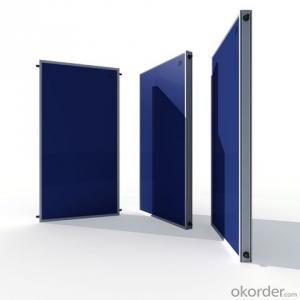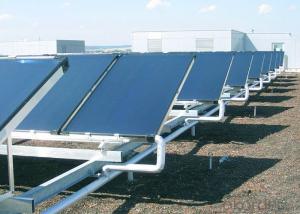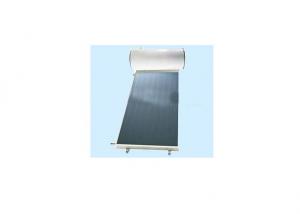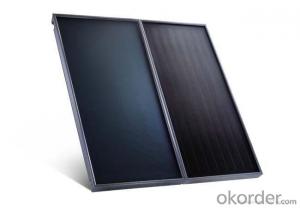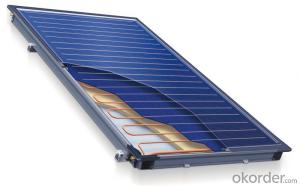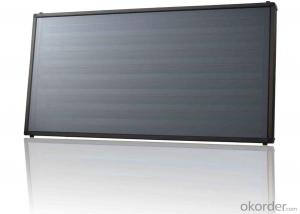Non-pressurized solar thermal collector for drying and heating solutions
- Loading Port:
- Shanghai
- Payment Terms:
- TT OR LC
- Min Order Qty:
- 500 pc
- Supply Capability:
- 10000 pc/month
OKorder Service Pledge
OKorder Financial Service
You Might Also Like
1. What can solar thermal dryer do?
If needs in heating or drying, there solar panels come to work for you.
For heating:
Heating demand on Hotel, Shopping center, office building ,convention hall and the like.
For drying:
Food stuffs, Tobacco , Herbal, Wood, Fruits and vegetables drying and so forth
In a nutshell, because of clean and low investment cost solar air collector has been used for heating and drying a lot.
2. How it works?
When daylight through the glass to reach the collector, the heat-absorbing absorbs solar radiation, and converts light energy into heat energy ,increase the absorber plate temperature. Indoor air by the fan flows through the absorber plate, through adequate heat, warming up, and goes back to indoor, so that the indoor temperature increases.
3. Features:
3.1 Absorber using high-performance heat-absorbing black chrome coating efficiency up to 85%.
3.2 Cover with low iron wove tempered glass, aluminum alloy frame side with professional, effective insulation,
high transmittance.
3.3 Overall sealing foam insulation materials, insulation thickness up to 50mm, efficient insulation, sealing effect is
outstanding.
3.4 Air flow using advanced aerodynamic design, makes the air absorb the maximum amount of heat, in this
way the effect of collectors in series is more prominent.
3.5 Green energy, consumes less than 50W.
3.6 Installation is simple, flexible control, according to local conditions.
3.7 Heating ability, every 2 m heating area is 24 square meters (according to the Chinese National Standard
Architecture)
3.8 Good quality, durable, no wearing parts, the service life of 20 years or more
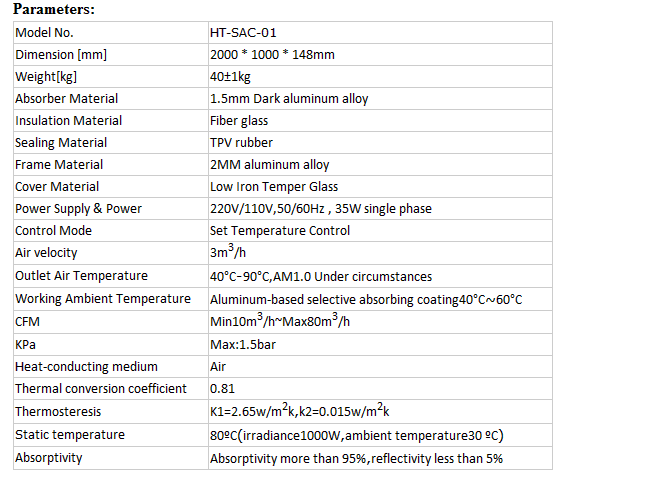
- Q:Can solar collectors be used for heating public transportation stations?
- Yes, solar collectors can be used for heating public transportation stations. Solar thermal systems can effectively capture and utilize solar energy to provide heating for these stations. This renewable energy source can reduce the reliance on fossil fuels and contribute to a more sustainable and environmentally friendly transportation infrastructure.
- Q:Can solar collectors be used in remote areas without electricity?
- Without access to electricity, remote areas can utilize solar collectors to harness the ample solar energy present in these regions. These devices, also known as solar panels or photovoltaic (PV) systems, are designed to convert sunlight into electricity. They do not necessitate a direct connection to an electrical grid or power supply, making them perfect for areas where electricity infrastructure may be absent or unreliable. In these remote regions, solar collectors can be installed to capture the abundant solar energy available. The panels absorb sunlight and transform it into electrical energy, which can be used for various purposes such as powering lights, appliances, and even charging batteries. This offers a sustainable and eco-friendly solution to meet the energy requirements of the remote communities. Solar collectors are particularly advantageous in remote areas due to their low maintenance needs and long lifespan. Once installed, the panels require minimal upkeep, reducing the necessity for regular maintenance visits. Additionally, solar collectors are durable and have an average lifespan of 25-30 years, making them a dependable and long-term energy solution for remote areas. Furthermore, the implementation of solar collectors in remote areas can reduce reliance on fossil fuels, decrease greenhouse gas emissions, and contribute to climate change mitigation efforts. By substituting traditional energy sources like diesel generators or kerosene lamps with solar power, remote communities can lower their carbon footprint and enhance overall environmental conditions. Although initial installation costs may present challenges in some cases, the long-term benefits of utilizing solar collectors in remote areas without electricity far outweigh the disadvantages. Governments, non-profit organizations, and international agencies have acknowledged the importance of renewable energy in remote areas and have implemented various programs and initiatives to support the adoption of solar collectors in these regions. In conclusion, solar collectors can certainly be employed in remote areas without electricity. They offer a reliable and sustainable energy source, reduce dependence on fossil fuels, contribute to environmental preservation, and enhance the overall living standards of remote communities.
- Q:Are solar collectors suitable for multi-unit buildings?
- Yes, solar collectors are suitable for multi-unit buildings. They can be installed on the roof or in a dedicated area to harness solar energy and provide hot water or electricity for all units in the building. This not only reduces the reliance on conventional energy sources but also lowers utility costs for residents. Additionally, advancements in technology have made solar collectors more efficient and adaptable, making them a viable option for multi-unit buildings.
- Q:Are there any disadvantages to using solar collectors?
- Yes, there are a few disadvantages to using solar collectors. Firstly, the initial cost of installing solar collectors can be quite high, making it less affordable for some individuals or businesses. Additionally, solar collectors require a significant amount of space for installation, which may limit their use in densely populated areas. Furthermore, solar collectors are dependent on sunlight, so their efficiency can be affected by variations in weather conditions or seasonal changes. Lastly, the manufacturing process of solar collectors can have environmental impacts, particularly if not properly recycled or disposed of at the end of their lifespan.
- Q:Can solar collectors be used for heating in areas with high humidity?
- Yes, solar collectors can be used for heating in areas with high humidity. While high humidity can affect the efficiency of solar collectors to some extent, it does not render them completely ineffective. Solar collectors work by capturing the sun's energy and converting it into heat, which can then be used for space heating or water heating. In areas with high humidity, the moisture in the air can reduce the amount of direct sunlight that reaches the solar collectors. This can result in a slightly lower efficiency compared to areas with lower humidity. However, even in high humidity environments, solar collectors can still generate enough heat to be used for heating purposes. Moreover, advancements in solar collector technology have led to the development of more efficient and effective systems that can better handle humid conditions. For example, some solar collectors use special coatings on their surfaces to minimize the impact of humidity on their performance. Additionally, the use of heat exchangers and insulation in solar heating systems can further enhance their efficiency in high humidity areas. It is important to note that while solar collectors can still be used for heating in areas with high humidity, it is essential to properly design and size the system to account for the unique environmental conditions. This may involve selecting the appropriate type of solar collector, optimizing its orientation and tilt, and considering factors such as shading and ventilation to maximize its performance. Overall, while high humidity can have a slight impact on the efficiency of solar collectors, they can still be effectively used for heating purposes in such areas with proper design considerations and technological advancements.
- Q:Can solar collectors be used for heating in desert regions?
- Yes, solar collectors can be used for heating in desert regions. In fact, desert regions are ideal locations for solar heating due to the abundance of sunlight available throughout the year. Solar collectors, such as solar thermal systems or solar water heaters, harness the sun's energy to generate heat. These collectors can capture sunlight and convert it into usable thermal energy, which can then be used to heat water, air, or other fluids for various applications. Deserts typically have high solar radiation levels and clear skies, which make them perfect for solar heating systems. The intense sunlight in these regions allows for efficient and effective collection of solar energy. Additionally, the high temperatures in desert regions make it easier to achieve desired heating levels using solar collectors. Solar heating systems can be used for a wide range of applications in desert regions, including space heating, water heating, and even industrial processes. Solar thermal systems can be integrated into residential, commercial, or industrial buildings to provide heating during colder months. They can also be used to heat swimming pools, which are popular in desert regions for recreational purposes. Moreover, solar heating systems offer numerous benefits in desert regions. They are environmentally friendly, as they utilize renewable energy and reduce reliance on fossil fuels. Solar collectors also have low operational costs as they require minimal maintenance once installed. Additionally, solar heating systems can help reduce energy bills in desert regions, where cooling costs can be high due to extreme temperatures. In conclusion, solar collectors can indeed be used for heating in desert regions. Their ability to harness the abundant sunlight and generate thermal energy makes them a reliable and sustainable heating solution for various applications in these areas.
- Q:Can solar collectors be used in vehicles?
- Yes, solar collectors can be used in vehicles. They can be installed on the roof or body of a vehicle to harness solar energy and convert it into electrical power. This power can then be used to charge the vehicle's battery or directly power auxiliary systems, reducing the reliance on fossil fuels and increasing energy efficiency. However, the effectiveness of solar collectors in vehicles depends on factors such as the size and efficiency of the collectors, weather conditions, and the vehicle's energy requirements.
- Q:Can solar collectors be used for heating government buildings?
- Yes, solar collectors can be used for heating government buildings. Solar heating systems can be installed on rooftops or nearby open spaces to capture the sun's energy and convert it into heat. This renewable energy source can help reduce reliance on fossil fuels and lower the carbon footprint of government buildings while providing efficient heating solutions.
- Q:Can solar collectors be used for generating electricity on oil rigs?
- Solar collectors have the ability to generate electricity on oil rigs. These devices, also referred to as solar panels, convert sunlight into electrical energy by utilizing the photovoltaic effect. By harnessing the ample sunlight available, they can be installed on oil rigs to produce clean and renewable energy. This electricity can then be utilized for a variety of purposes on the rig, including powering lighting, equipment, and communication systems. Incorporating solar collectors into oil rigs lessens the dependence on conventional fossil fuels and contributes to a more sustainable and environmentally-friendly energy source. Moreover, solar panels aid in diminishing the overall carbon footprint of the oil rig by offsetting a portion of energy consumption and decreasing greenhouse gas emissions.
- Q:Can solar collectors be used for heating pharmaceutical manufacturing plants?
- Yes, solar collectors can be used for heating pharmaceutical manufacturing plants. Solar thermal systems can provide a sustainable and cost-effective solution for heating processes in these plants, reducing the reliance on fossil fuels and minimizing carbon emissions. By harnessing the sun's energy, solar collectors can generate hot water or steam required for various manufacturing processes, ensuring a greener and more environmentally-friendly operation.
1. Manufacturer Overview |
|
|---|---|
| Location | |
| Year Established | |
| Annual Output Value | |
| Main Markets | |
| Company Certifications | |
2. Manufacturer Certificates |
|
|---|---|
| a) Certification Name | |
| Range | |
| Reference | |
| Validity Period | |
3. Manufacturer Capability |
|
|---|---|
| a)Trade Capacity | |
| Nearest Port | |
| Export Percentage | |
| No.of Employees in Trade Department | |
| Language Spoken: | |
| b)Factory Information | |
| Factory Size: | |
| No. of Production Lines | |
| Contract Manufacturing | |
| Product Price Range | |
Send your message to us
Non-pressurized solar thermal collector for drying and heating solutions
- Loading Port:
- Shanghai
- Payment Terms:
- TT OR LC
- Min Order Qty:
- 500 pc
- Supply Capability:
- 10000 pc/month
OKorder Service Pledge
OKorder Financial Service
Similar products
New products
Hot products
Hot Searches









